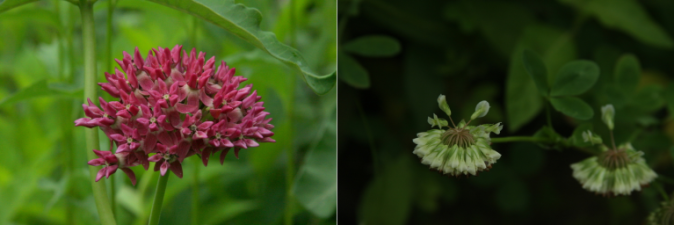Olivia Hajek spent 10 weeks this summer studying woodland restoration at Shaw Nature Reserve with CCSD scientist Leighton Reid. She participated in MBG’s NSF-funded Research Experience for Undergraduates (REU) program.

Wildflowers in the restored Dana Brown Woods: purple milkweed (Asclepias purpurescens; left) and buffalo clover (Trifolium reflexum; right).
During my ten weeks in Missouri, I completed a research project evaluating the role environmental conditions play in restoration at Shaw Nature Reserve. Specifically, I worked in the Dana Brown Woods management unit, a part of the Missouri Ozark foothills that features diverse plant communities across its heterogeneous landscape. Sixteen years ago, the Dana Brown Woods was a closed-canopy woodland highly invaded by eastern red cedar. However, restoration practices including reintroduction of fire and mechanical removal of woody shrubs like eastern red cedar have dramatically changed plant communities since 2000. I was very fortunate coming into this project because there was extensive data about the plant communities in the Dana Brown Woods from 2001-2012 while restoration was occurring. A local botanist, Nels Holmberg, monitored understory plants beginning a year before the first fire, creating complete information about the plant community before restoration and as it changed over time.
We wanted to see how different environmental conditions affect how plant communities change over time in response to restoration. To answer this question, we visited 300 points across the woodland and measured several environmental parameters, including aspect, slope, rockiness, elevation, and juniper stump density (juniper stumps decay slowly, so many of the trees cut in 2006 were still visible).

Fieldwork in Dana Brown Woods. Olivia makes friends with a hog peanut (Amphicarpaea bracteata).
Just from field observations, we could see noticeable differences in the environment and plant community composition across the woodland. Higher slopes were rockier, covered in old juniper stumps, and rich in sunflowers, whereas the lower regions near the Meramec River floodplain had deeper soil and more mesic plant species, like spicebush.
Data analysis confirmed that environmental gradients moderated plant community change over time. Higher, rockier areas experienced greater plant species turnover and greater increases species richness and abundance from 2001-2012, whereas shaded valleys changed relatively little.

Plant composition change from 2001-2012 increased with elevation, particularly during spring surveys. BC = Bray-Curtis dissimilarity, which measures the difference in plant species composition between a plot in 2001 and itself in 2012. Juniper, red oak, and white oak were subjectively determined habitat classifications at the outset of the study.
Our observations were likely driven by differential fire behavior across the woodland. Historically, fires were a frequent disturbance in the Ozark foothills. Four prescribed fires from 2001-2012 probably had larger impacts on the drier upland areas than in the wet lowlands, which would not have burned as well.
Quantifying how ecological restoration practices, like prescribed fire, vary across environmental gradients is important for land management planning, especially in the Ozark foothills where the landscape is so heterogeneous.

Leighton stood by while Olivia presented her research to the public at Sensational Summer Nights.